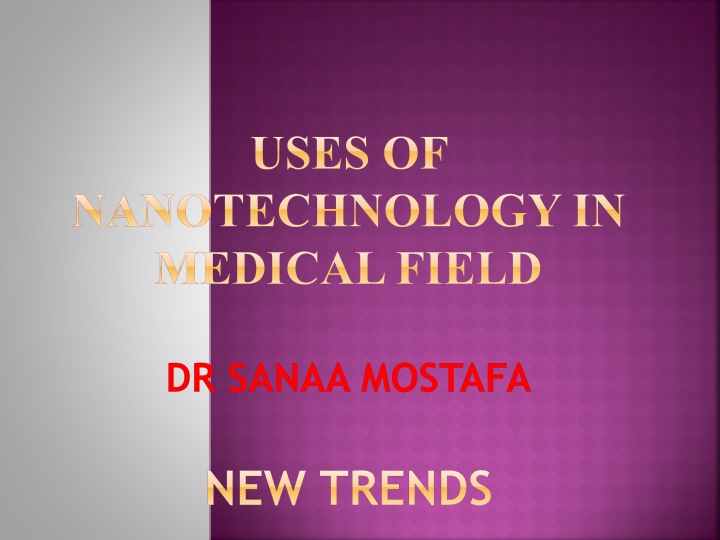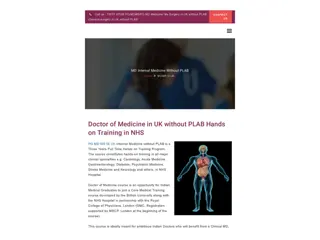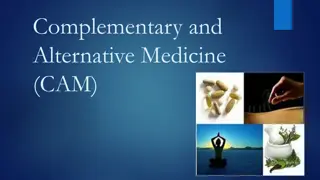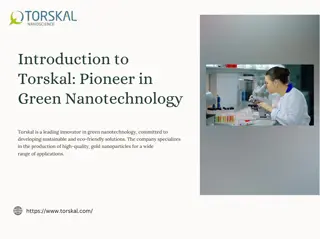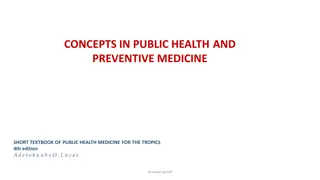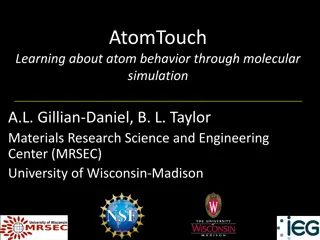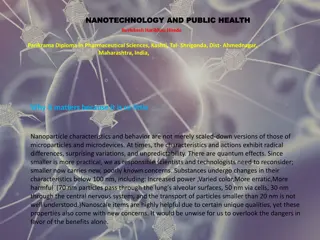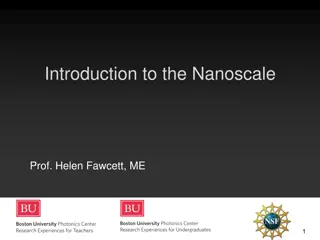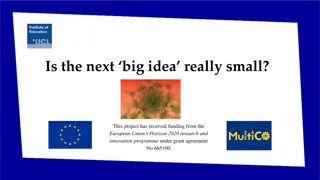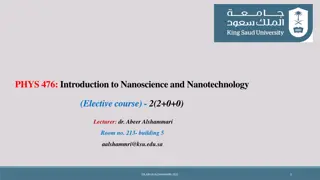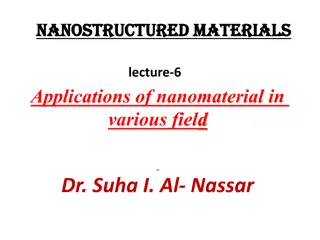Nanotechnology in Medicine: Current Trends and Applications
Nanomedicine, a crucial field of nanotechnology, focuses on utilizing nanomaterials for disease diagnosis and treatment. It addresses challenges such as toxicity and environmental impact. Nanoparticles are employed in drug delivery systems, cancer therapy, and targeted treatments, reducing harm to healthy cells and enabling earlier disease detection. Additionally, nanotechnology plays a significant role in tissue engineering and vaccine delivery advancements.
Download Presentation

Please find below an Image/Link to download the presentation.
The content on the website is provided AS IS for your information and personal use only. It may not be sold, licensed, or shared on other websites without obtaining consent from the author.If you encounter any issues during the download, it is possible that the publisher has removed the file from their server.
You are allowed to download the files provided on this website for personal or commercial use, subject to the condition that they are used lawfully. All files are the property of their respective owners.
The content on the website is provided AS IS for your information and personal use only. It may not be sold, licensed, or shared on other websites without obtaining consent from the author.
E N D
Presentation Transcript
USES OF NANOTECHNOLOGY IN MEDICAL FIELD DR SANAA MOSTAFA NEW TRENDS
OUT LINES Introduction Definition Uses of nanotechnology in medical field
Nanomedicine ranges from the medical applications of nanomaterials and biological devices, to nanoelectronic biosensors, and even possible future applications of molecular nanotechnology such as biological machines. Current problems for nanomedicine involve understanding the issues related to toxicity and environmental impact of nanoscale materials.
Nanomedicine is the most important field of Nanotechnology. The nano level gadgets and materials are used for diagnosing and treatment of diseases. Nano-Pharmacology has generated a specific category of smart drugs that affect negligible side effects.
DEFINITION: Nanomedicine is the medical application of nanotechnology. Nanotechnology is derived from the combination of two words Nano and Technology. Nano means very small or miniature. So, Nanotechnology is the technology in miniature form. It is the combination of Bio- technology, Chemistry, Physics and Bio-informatics, etc..
Nanotechnology is playing an increasingly major role in the healthcare industry. Examples include the use of nano-particles in cancer therapy and targeted drug delivery systems. Nanotechnology is also widely issued in tissue engineering applications
USES OF NANOTECHNOLOGY OF FIELD Drug Delivery One application of nanotechnology in medicine currently being developed involves employing nanoparticles to deliver drugs, heat, light or other substances to specific types of cells (such as cancer cells). Particles are engineered so that they are attracted to diseased cells, which allows direct treatment of those cells.
This technique reduces damage to healthy cells in the body and allows for earlier detection of disease. Also using nanoparticles to deliver vaccine. The nanoparticles protect the vaccine, allowing the vaccine time to trigger a stronger immune response. Researchers are developing a method to release insulin that uses a sponge-like matrix that contains insulin as well as nanocapsules containing an enzyme.
For example researchers at North Carolina State University are developing a method to deliver cardiac stem cells to damaged heart tissue. They attach nanovesicles that are attracted to an injury to the stem cells to increase the amount of stem cells delivered to an injured tissue.
Diagnostic Techniques Researchers at Worcester Polytechnic Institute are using antibodies attached to carbon nanotubes in chips to detect cancer cells in the blood stream. The researchers believe this method could be used in simple lab tests that could provide early detection of cancer cells in the bloodstream.
A test for early detection of kidney damage is being developed. The method uses gold nanorods functionalized to attach to the type of protein generated by damaged kidneys. When protein accumulates on the nanorod the color of the nanorod shifts. The test is designed to be done quickly and inexpensively for early detection of a problem.
Antibacterial Treatments Researchers at the University of Houston are developing a technique to kill bacteria using gold nanoparticles and infrared light. This method may lead to improved cleaning of instruments in hospital settings. One of the earliest nanomedicine applications was the use of nanocrystalline silver which is as an antimicrobial agent for the treatment of wounds. A nanoparticle cream has been shown to fight staph infections.
Wound Treatment For trauma patients with internal bleeding another way to reduce the blood loss is needed. Researchers at Chase Western Reserve University are developing polymer nanoparticles that act as synthetic platelets. Lab tests have shown that injection of these synthetic platelets significantly reduces blood loss.
Cell Repair Nanorobots could actually be programmed to repair specific diseased cells, functioning in a similar way to antibodies in our natural healing processes
